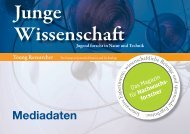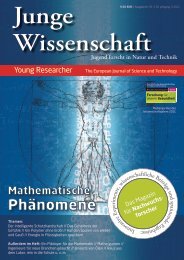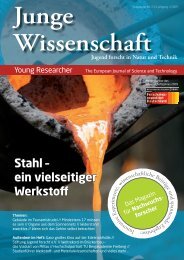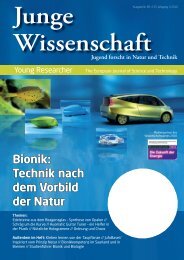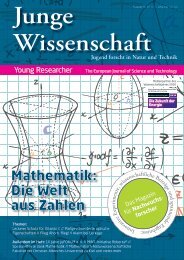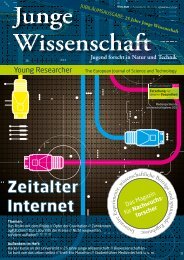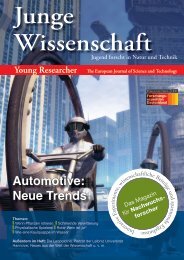2008: Das Jahr der Mathematik - Junge Wissenschaft
2008: Das Jahr der Mathematik - Junge Wissenschaft
2008: Das Jahr der Mathematik - Junge Wissenschaft
Create successful ePaper yourself
Turn your PDF publications into a flip-book with our unique Google optimized e-Paper software.
Jugend forscht<br />
Jugend forscht<br />
3.4 'Training' effect<br />
Half of the subjects participated first in the<br />
high-or<strong>der</strong> adaptation experiment and half of<br />
the subject participated first in the primaryvisual-areas<br />
adaptation experiment. For each<br />
subject the total accuracy level was calculated<br />
for both experiments and a total average was<br />
calculated. A minor improvement trend was demonstrated<br />
in the second experiment, regardless<br />
of experiment-type. This might be due to<br />
some 'training' effect, in which the subjects are<br />
more familiar with the task and thus achieve<br />
better performances.<br />
Figure 4: The percentage of change in accuracy between the second and the fourth blocks. A significant improvement<br />
in performances was indicated after interrupting adaptation.<br />
3.1 The influence of adaptation /<br />
interruption (of adaptation) on response<br />
accuracy<br />
The first block in both experiments was supposed<br />
to generate adaptation and the third one<br />
was supposed to interrupt adaptation. The second<br />
and fourth blocks were similar which enabled<br />
us to use them as internal controls. We,<br />
therefore, focused on the responses given in the<br />
second and fourth block, assuming that significant<br />
differences in performances between these<br />
two homologue blocks result from the primer<br />
block.<br />
Experiment A: As we can see in figure 4, in<br />
73 % of the events, the subjects’ ability to note<br />
minor changes in the displayed picture is increasing<br />
after the interrupting block. In 18 % of<br />
the events, the value of accuracy remained the<br />
same and in 9 % of the events accuracy level<br />
decreased.<br />
The properties of the first error after adaptation<br />
effect were investigated. It was found that in<br />
both experiments errors due to changes in contrast<br />
level were the most dominant (see Fig. 6).<br />
3.3 Comparison of the two experiments<br />
First of all, we compared the number of errors<br />
in the two experiment types. The average percentages<br />
of total errors did not show any significant<br />
differences.<br />
We also compared the average percentages of<br />
errors due to different contrast levels. As it can<br />
be seen, the errors due to contrast levels in both<br />
the primary and high-or<strong>der</strong> experiment had no<br />
significant difference (see fig 7).<br />
4 Discussion<br />
There have been many studies on adaptation<br />
effects using fMRI but hardly any psychophysical<br />
experiments on short-term adaptation.<br />
The study of short-term adaptation is important<br />
because it can aid in un<strong>der</strong>standing neuronal<br />
mechanisms better and can also help scientists<br />
in mapping the functional properties of<br />
cortical neurons. The behavioral analyses performed<br />
in this experiment, which successfully<br />
showed adaptation, can be carried out through<br />
fMRI for a more detailed description of un<strong>der</strong>lying<br />
neuronal activity. The experiment proved<br />
adaptation occurred when the subject responded<br />
to the second block of images less accurately<br />
after looking at a repeated image than<br />
after looking at a block with altered images.<br />
This adaptation, indicated by other scientists,<br />
was due to fatiguing neurons responding less<br />
than normal.<br />
We assumed that the response time of a subject<br />
after acquiring adaptation would grow due to<br />
the conflict between the adapting stimulus and<br />
Experiment B: The same analysis was done on<br />
the data <strong>der</strong>ived from Experiment B, where we<br />
found that in 65 % of the events the subjects’<br />
ability to note minor changes in the displayed<br />
picture is increasing after the interrupting<br />
block. In 22 % of the events, the value of accuracy<br />
remained the same and in 13 % of the<br />
events accuracy level decreased.<br />
3.2 Error analysis<br />
Tracing the most confusing event, we examined<br />
the distribution of error types in experiment A<br />
and B. From these results (see Fig. 5) it can be<br />
clearly seen that in both experiments most of<br />
the errors were due to contrast modifications.<br />
Figure 5: Distribution of error types. The total number of errors was analyzed according to its "event" type. The percentage<br />
of each group was calculated for each subject separately and was averaged across subjects.<br />
Young Researcher 35



